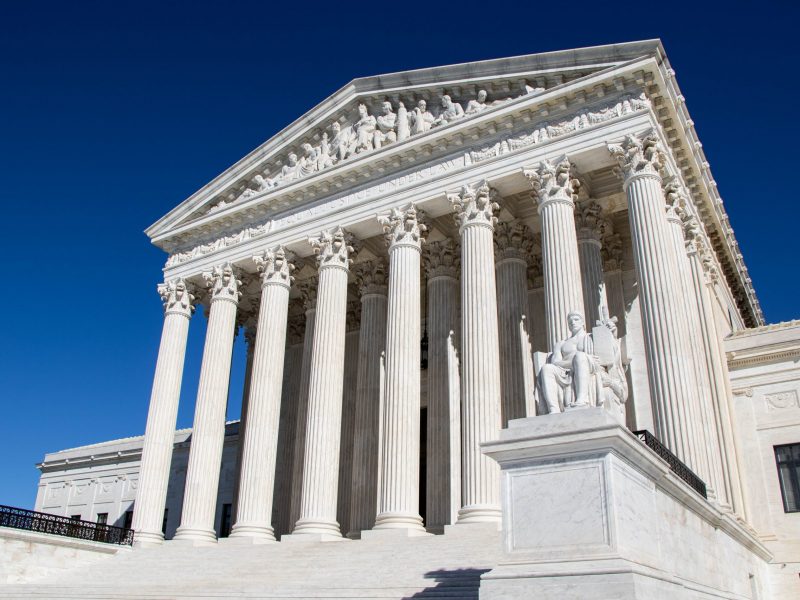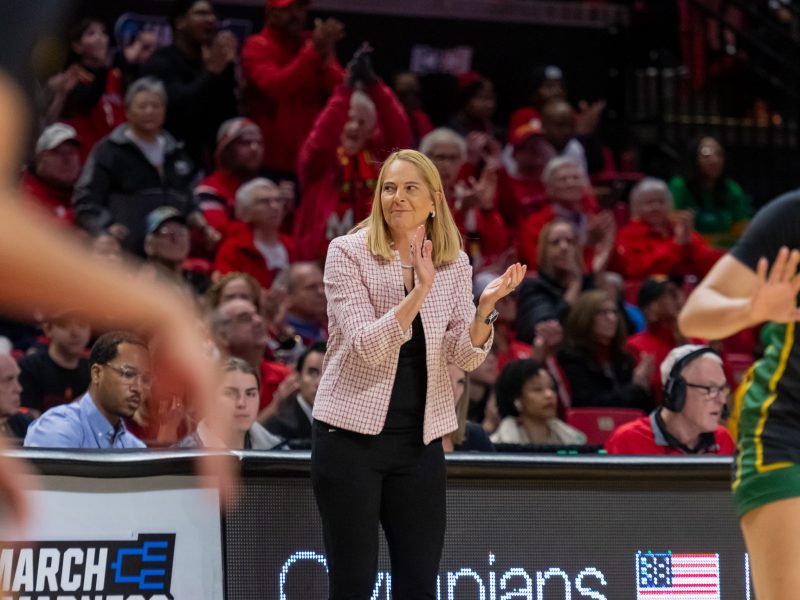[Editor’s note: This is part 1 of a 4-part series addressing the integration and history of blacks at the university.]
There is Harry “Curley” Byrd, his winning smile and wispy mane of hair splashed across the front page of The Diamondback as he crowns a twentysomething coed at Homecoming. This was how university students saw Byrd for much of his 20-year reign from 1935 to 1954 as university president — a deified football coach and smooth-talking politician who could do no wrong.
But Byrd — whom the Maryland football team’s stadium is named after — also led the university as blacks began pushing for integration of the nation’s public universities, an issue Byrd tackled with determined but questionable motives.
On one hand, he fought perhaps harder than anyone in the state for the funding of black colleges. Yet at the same time, those efforts were largely seen as Byrd’s way of ensuring that the College Park campus remained segregated — make the branch campuses adequate and maybe the Negroes would be content.
He was a segregationist and an integrationist at the same time, a politician trying to please everyone.
By the time Byrd left to run for governor, the university had been forced to integrate by repeated legal challenges, but despite the 1954 Brown v. Board of Education ruling, it remained largely devoid of blacks through the early 1970s. Left in place was a system a 1993 university report would call “at best neglectful, at worst hostile” toward blacks.
“THE DEVIL HATH POWER”
From the start, the university was torn over what to do with blacks.
The university’s founder, Charles Benedict Calvert, was a pro-slave Unionist. The Maryland Agricultural College — as it was first known — opened in the 1850s with slaves constructing the college’s buildings and working on the farms.
Yet Benjamin Hallowell, its first president, was an abolitionist who accepted his appointment on the condition the school not use slave labor on its farms.
Through its first decades, the university was largely an agricultural and military school, and its students enjoyed fraternities, athletics and social life. Especially popular was Kappa Alpha’s annual “Cotton Picker’s Minstrel Show.”
In 1935, President Raymond Pearson was forced out in a coup-like fashion after losing support from the faculty and students. Ready to step in was the president’s assistant, “Curley” Byrd, who had been jockeying for the position when it became clear Pearson’s days were numbered.
Byrd was a former football player, supremely confident and often rumored to be fooling around with coeds. “The Devil hath power to assume a pleasing shape,” said the caption beneath his graduation yearbook photo, and newspaper columnists years later would call him “the handsomest figure in American politics.”
When Byrd took over, those in charge had never known anything other than segregation.
“There were no public figures among whites who embraced integration [in the 1930s],” said university historian and history professor emeritus George Callcott. “The impulse for integration came from blacks.”
Until then, keeping blacks out of the university was commonplace. When Byrd received an angry letter about several black spectators being turned away from a basketball game at Ritchie Coliseum, Byrd wrote to the state’s attorney general asking how he should respond, “if at all.” In Byrd’s opinion, there was “no necessity for a reply other than mere acknowledgment,” Byrd said.
Byrd couldn’t ignore them all. Thurgood Marshall — who had been denied admission to the university’s law school — was beginning to launch a series of test cases to challenge universities nationwide.
When Donald Murray filed suit to attend the university’s law school, Registrar W.M. Hillegeist lamented in papers now stored in the archives in Hornbake Library that “Negroes can’t be denied much longer their constitutional right.” He worried that whites in Maryland and the South would not “accept complacently the enforced admission of Negroes to educational institutions created for Whites.”
Hillegeist wrote a letter to Byrd, telling of the “nigg’s” case, to which Byrd replied in a letter, “I think I have had a couple of real problems dumped in my lap!”
The university opposed Murray’s admission, and Marshall was furious. According to Callcott, Marshall showed up on the campus unannounced and stormed into Shoemaker Hall, which was then the administration building and library. He demanded to see Byrd and was told by a secretary that he was busy. No matter, Marshall said, barging into the president’s office.
Byrd told him Murray was not qualified. Marshall told him he’d see him court.
Even the more liberal student body was opposed to integration. The Diamondback opined that the test cases were “an unexcusable waste of money and effort.”
Chalking it up to “undeniable racial prejudice,” editors wrote that “although such a situation is seemingly unfair, it must be admitted that unsatisfactory or even disastrous results would evolve if Negroes were allowed admittance into the University. Their life would be a virtual misery, filled with the highest degree of abuse and intolerance. It would defeat the purpose of advancement of the race.”
A year later, editor in chief Carl Humelsine gushed that Byrd “exemplifies all that is fine and progressive in the State University education. He represents a wise administration that can see every viewpoint including that of the student, the faculty member and the taxpayer.”
All, that is, except “the Negro.”
Byrd’s infamous comment — “If we don’t do something about Princess Anne [now the University of Maryland, Eastern Shore], we’re going to have to accept Negroes at College Park — where our girls are” — didn’t appear in the newspaper. And after graduating that spring, Humelsine was appointed Byrd’s special publications and public relations assistant.
THE PRINCESS ANNE PROBLEM
As the 1940s approached, Byrd was making a serious case for the university’s Princess Anne campus. Byrd originally protested its purchase, but when it was acquired against his wishes, he pushed hard to fund it to a much higher degree than the state had intended.
As Byrd saw it, he had three options: open the university’s doors to all, create new school for blacks or turn all schools over to private control.
“None of these alternatives seems to offer an intelligent solution,” he told the legislature in 1939. Admitting both blacks and whites would “violate the educational and social philosophy of the state’s biracial system,” and creating new schools was impractical because of financial reasons.
Around this time, public opinion started to shift. Swedish author Gunnar Myrdal’s 1945 book, American Dilemma, detailed a hostility toward blacks that, Myrdal wrote, rivaled the Nazi’s treatment of Jews. Callcott said the book was a wake-up call for the nation, especially for members of a younger generation more progressive than their parents.
The Diamondback started to embrace the black cause. Though they didn’t express opinions or print letters to the editor on the topic, articles in which Byrd discussed black students were getting important play in the paper under editor J. Allen Bowers. The “disgraceful neglect” of blacks at the Princess Anne campus was reported in great detail.
The veterans were returning from the war effort, enrolling in universities and assuming leadership positions. The Diamondback would be taken over by a group of 23 and 24 year olds returning to an America much different than the one they had left, and with a different opinion on how to report on it.
NOT THE SAME OLD STORY
The first day of the fall semester of 1950, a story about registration in The Diamondback said it was the “same old story.”
But there would be nothing routine about that year’s registration.
Just one month later, the university was ordered to accept two black students, Esther McCready and Parren J. Mitchell, to its nursing school in Baltimore and College Park graduate school, respectively.
Byrd had anticipated as much. While the university was able to offer comparable undergraduate services at the isolated Eastern Shore campus, it wouldn’t be able to match the services and specialties of its graduate schools.
University officials set up a special graduate course for Mitchell to take as an off-campus student at its Baltimore schools. A university professor testified this was done expressly to keep him off the College Park campus.
Judge John T. Tucker of the Baltimore City Court found the “requirement he be an off-campus student deprives him of his constitutional rights to the equal protection of the laws.” Mitchell would go on to be a U.S. Congressman.
Byrd still wasn’t convinced. He pushed for a referendum to Maryland voters to decide whether Negroes should be admitted to the university, or if millions of dollars should be spent to provide equal educational facilities for them elsewhere in the state. He was sure that “99 percent” of blacks preferred their own facilities after discussions with prominent black leaders.
Despite the realization it would be more economically sound for the university to integrate than to fund multiple colleges, Byrd couldn’t fathom a College Park that included blacks and whites, but seemed resigned to the fact that change was coming. At fall convocation, he told students the university would, “meet the question in obedience to the law” — not exactly a ringing endorsement for integration.
Meanwhile, Marshall and the National Association for the Advancement of Colored People were still pushing test cases.
BYRD PAYS
In 1949, a student at Morgan State College received a letter in the mail. It was from the NAACP, looking for students to participate in a “test case” to racially integrate the University of Maryland. After graduating from Dunbar High School, a job placement employee advised the student continue his education. He was sharp and was ready for the task.
Hiram Whittle, a 20-year-old from a family of 11 who spent his childhood carrying home grocery bags from the local market for tips, accepted the offer.
The university initially balked. Advised the case was unwinnable, the university allowed Whittle to enroll in the spring of 1951.
Whittle told The Diamondback last year he didn’t experience any incidents of discrimination, a claim his sister disputed. He lived in Temporary Dormitory One, near Ritchie Coliseum, and can be seen beaming in a yearbook picture with his 23 dormmates.
“I was used to getting along with people,” said Whittle, a devout Jehovah’s Witness who lives in Baltimore.
Ellis Rottman, a Diamondback editor at the time, said students were indifferent toward the integration. They didn’t pay much attention, let alone protest the admission of black students. Rottman, 74, a retired writer and editor, even vaguely remembers riding in a carpool to Baltimore with Whittle.
“The engineering student, right?” he asked when recently contacted.
Whittle left in June 1952 without a degree, but his entrance had a lasting impact. Two years later, the Supreme Court would end segregation in public schools with the historic Brown v. Board of Education ruling.
Byrd left in 1954 after 43 years with the university to make an unsuccessful run for the State House. He was attacked from all sides for his handling of integration at the university.
His Democratic primary opponent, George P. Mahoney, charged Byrd was an integrationist, giving money to black schools. Meanwhile, his Republican opponent, Theodore R. McKeldin, “came down on him like a ton of bricks,” according to Callcott, charging he was a segregationist who was behind the times.
He left behind a university with a strong football program and many new buildings — and not much else. A Southern conservative with a quiet demeanor would have to lift the school from its academic doldrums and implement a plan to integrate as student activism reached a crescendo.
Tomorrow: Part 2 of the series explores the creation of the Black Student Union, the increasing activism and a university president in a precarious position.


